Facts About Rufous hornero
The rufous hornero, also known as the red ovenbird, is a medium-sized bird native to South America. This delightful bird can be found in countries such as Argentina, Uruguay, Brazil, Bolivia, and Paraguay. It thrives in diverse habitats, including savannas, scrublands, pastures, and even agricultural areas.
Primarily an insectivore, the rufous hornero forages for insects and arthropods on the ground, though it won't pass up a few breadcrumbs if available. Rufous horneros are notable for their lifelong monogamous relationships. These bird couples collaboratively build unique clay "oven" nests, which they place in trees or on man-made structures.
The breeding season for the rufous hornero occurs during the austral summer. Their nests typically contain two to four eggs, which are incubated for approximately 14-18 days. After hatching, the chicks are fed for another 23-26 days before they are ready to leave the nest. However, these fledglings often remain in their parents' territory for up to six months.
Thanks to their adaptability, rufous horneros have flourished in human-modified environments and are not considered endangered. In fact, the IUCN lists them as a species of least concern. They hold a special place in the hearts of people in Argentina and Uruguay, where they are celebrated as the national bird.
Taxonomically, the rufous hornero belongs to the genus Furnarius, which comprises five other species native to South America. The name "hornero" derives from the Latin word "furnus" meaning "oven" a reference to their distinctive nest-building skills. Five recognized subspecies of the rufous hornero exhibit slight variations in plumage and size.
With its medium size, reddish-brown feathers, square tail, and slightly curved bill, the rufous hornero is easy to recognize. This fascinating bird has successfully adapted to a variety of environments and plays a vital role in its ecosystem.

 Bolivia
Bolivia